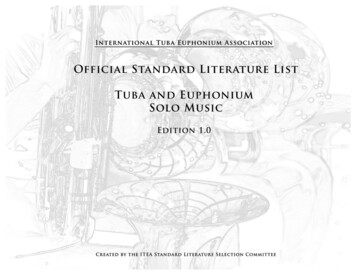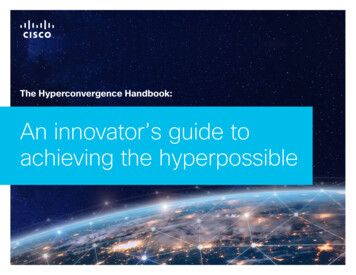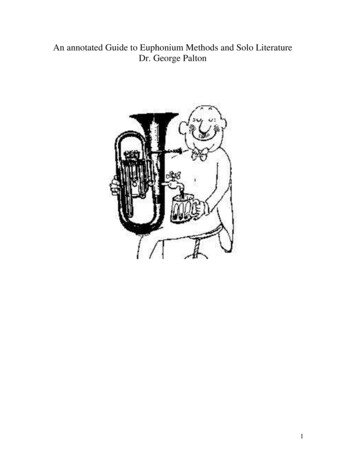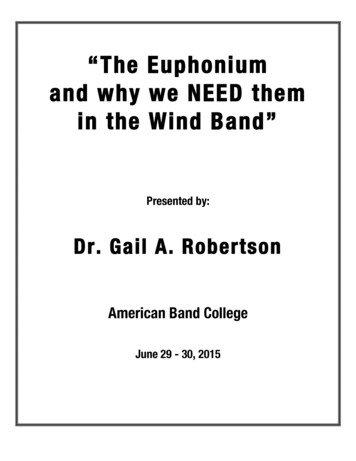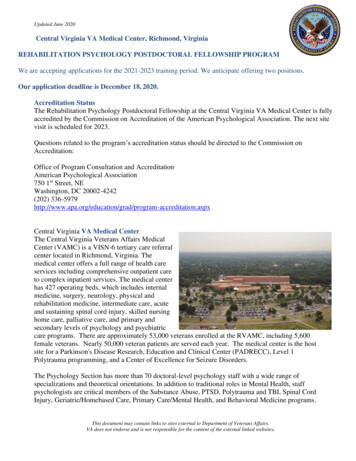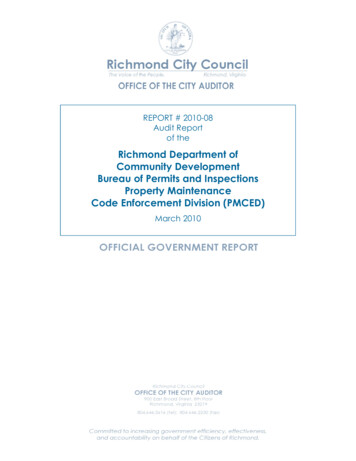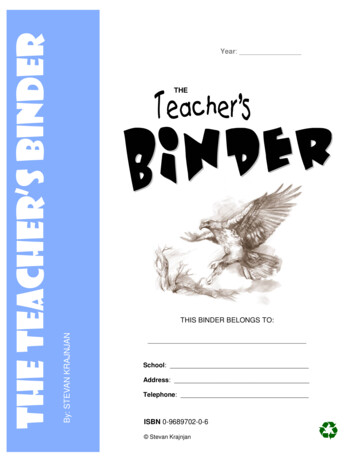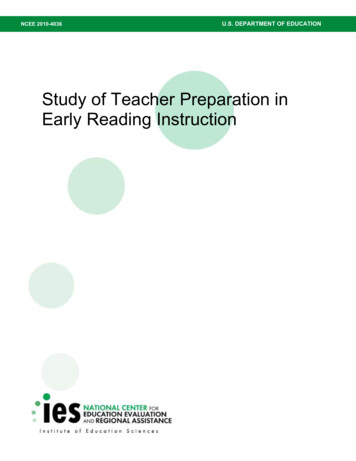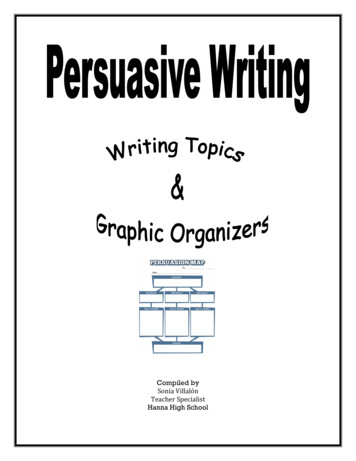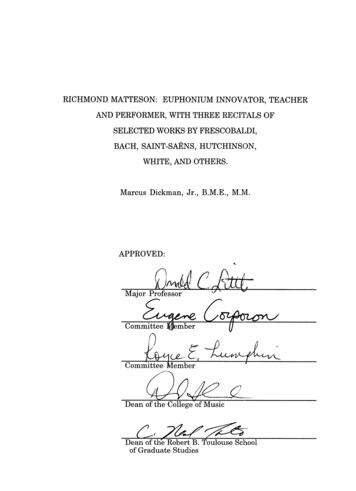
Transcription
RICHMOND MATTESON: EUPHONIUM INNOVATOR, TEACHERAND PERFORMER, WITH THREE RECITALS OFSELECTED WORKS BY FRESCOBALDI,BACH, SAINT-SAENS, HUTCHINSON,WHITE, AND OTHERS.Marcus Dickman, Jr., B.M.E., M.M.APPROVED:V4NWwMajor Professor007k.00/CommitteemberCommitteeemberDean of the College of MusicDean of the Robert B. Toulouse Schoolof Graduate Studies
3 7qo'S7RICHMOND MATTESON: EUPHONIUM INNOVATOR,TEACHER AND PERFORMERDISSERTATIONPresented to the Graduate Council of theUniversity of North Texas in PartialFulfillment of the RequirementsFor the Degree ofDOCTOR OF MUSICAL ARTSByMarcus Dickman, Jr., B.M.E., M.M.Denton, TexasAugust, 1997
Dickman, Marcus, Jr., Richmond Matteson:EuphoniumInnovator, Teacher and Performer, with Three Recitals of SelectedWorks By Frescobaldi, Bach, Saint-Sa ns, Hutchinson, White andOthers. Doctor of Musical Arts (Performance), August, 1997, 97 pp., 23examples, 3 tables, 3 appendices, and bibliography.An examination is conducted of the life, career and musical stylesof Richmond Matteson, an influential jazz euphonium and tubaperformer of the twentieth century. The study includes a brief history ofthe euphonium's role in concert bands. A description of Matteson'sbackground as a musician and clinician including education,influences and career changes will also be discussed. Analysis ofMatteson's improvisational style and a transcription from the recordingDan's Blues is included. A formal analysis of Claude T. Smith'sVariations for Baritone is provided, as well as a brief biography of thecomposer. Matteson's stylistic traits which Smith employed for thecomposition of Variations for Baritone are illustrated.The conclusioncalls for further study of jazz styles by euphoniumists with morefrequent performances of Variations for Baritone. Appendices includelists of Matteson's compositions and arrangements, a selecteddiscography and a list of clinics and performances from 1982-1992.
Tape recordings of all performances submitted as dissertationrequirements are on deposit in the University of North Texas Library.iii
ACKNOWLEDGMENTSI would like to recognize my colleagues, friends, teachers and familywho gave their expertise, encouragement and selfless dedication during thecompletion of my terminal degree. Special thanks are given to: DonaldLittle who has given freely of his time and musicianship, and for his kindhospitality; Dr. Royce Lumpkin for his proofreading and helpful advice andguidance; Eugene Corporon for serving on my DMA committee; PeggyHeinkle-Wolfe who was extremely helpful in the theoretical portions of thisstudy; and Dr. Priscilla VanZandt for proofreading and giving invaluableeditorial suggestions. I would also like to thank Dr. William Prince, BarryGreene, and Kevin Bales for their assistance in the reproduction of themusical examples contained in this paper.I would like to thank my parents, Marcus, Sr., and Janet Dickman,for their encouragement and support through the long years of my collegeeducation. To my wife Patrice, and children, Jacob and Corrine, I dedicatethis treatise. Their sacrifice throughout my studies are one of the mainreasons I was able to complete my degree.A musical discussion without examples is unintelligible.I wish tothank Mr. Frank Fendorf at Wingert-Jones Music, Inc. for giving mepermission to reproduce selected musical examples.Last of all, a special note of gratitude to Michelle Matteson forhelping me to document the remarkable life and career of her husband.iv
TABLE OF CONTENTSPageACKNOW LEDGM ENTS .ivRECITAL PROGRAMS.viiLIST OF MUSICAL EXAMPLES .LIST O F TABLES .xixiiiChapterI.INTRODUCTION .II.A BRIEF HISTORY OF THE EUPHONIUM AND ITSROLE IN THE AMERICAN CONCERT BAND.3III.IV.V.VI.RICHMOND MATTESON: PERFORMER, EDUCATOR,IN N OVATO R .110MATTESON'S CONTRIBUTION TO TUBA ANDEUPHONIUM PERFORMANCE.24THE VARIATIONS FOR BARITONE BYCLAUDE T. SM ITH .CONCLUSION AND SUMMARY.57V40
AppendicesPageA.MATTESON'S COMPOSITIONS AND ARRANGEMENTSFOR JAZZ ENSEMBLE AND SOLOIST, FOR BRASS BANDAND SOLOIST, FOR BRASS BAND ALONE, PUBLISHEDJAZZ ENSEMBLE COMPOSITIONS, AND TUBAJAZZCOMPOSITIONS AND ARRANGEMENTS.61B.SELECTED DISCOGRAPHY OFRICHMOND MATTESON.68C.MATTESON'S CLINICS AND CONCERTS 1982 - 1990.70BIBLIO GRAPH Y .vi92
University of North TexaspresentsA Graduate RecitalMARC DICKMAN, euphoniumassisted byEvelyn Barthold, pianoMonday, June 28, 19935:00 p.m.Concert HallPROGRAM. . . .JuliusConcertinoNo.Kiengel1 in B' Major, Opus 7.arr. Leonard FalconeCanzona IIfor Basso Solo.Girolamo FrescobaldiLeCygne. Camille Saint-Saensarr. Leonard Falcone-- pauseSonatina.Barcarolle Et Chanson Bachique. Warner Hutchison. .a.Jules.Beautiful Colorado.Semler-Collery. . . . . .'. 0Joseph DeLucaPresented in partial fulfillment of therequirements for the degree ofDoctor of Musical Artsvii
University of North TexaspresentA Graduate RecitalMARC DICKMAN, euphonium, bass-tromboneaccompanied byEvelyn Barthold, pianoassisted byLarry Jones, trumpet - Bill Stowman, trumpetTom Brantley, trombone 9 Marcia Spence, horn * John Rider, tuba5:00 pmMonday, June 12, 1995Concert HallDonald H. WhiteLyric Suite .Allegro guistoAndante sostenutoAllegro energico-Adagio cantabileAllegro Maestoso per trombone basso e pianoforte .Concert Variationsfor Euphonium and Piano .CapriccioVar. ISicilianoVar. IIVar. IIIVar. IVVar. VVar. VIVar. VIIJan KoetsierJan BachRipresaScherzoRecitativoCoroFugaConcerta 6 inBb from theViolin Concert in E Major, BWV1042 .AllegroAdagioAllegro assaiPresented in partial fulfillment of therequirements for the degree ofDoctor of Musical ArtsviiiJohann Sebastian Bacharr. Ryohei Nakagawa
University of North TexaspresentsA Graduate RecitalMARC DICKMAN, euphoniumaccompanied byJudi Rockey Bradetich, piano6:30 pmMonday, July 1, 1996Fantasia.t.o.0.GordonConcert HallJacobPi ce en Forme de Habafiera.MauriceRavelMorceau De Concours.J. Ed. Baratpause--Le Fleurgue tu n'avaisjet. .Georges BizetBelieve Me If All Those Endearing Young Charms.Simone Mantiaarr. David WerdenPresented in partial fulfillment of therequirements for the degree ofDoctor of Musical Artsix
University of North Texas-u-7presentsA Graduate Lecture RecitalMARC DICKMAN, euphoniumassisted bySteven Harlos, piano * Mike McGuirk, bassRich Matschulat, drumsRecital Hall6:30 pmMonday, April 14, 1997RICHARD MATTESON: EUPHONIUM INNOVATOR,TEACHER AND PERFORMER WITH THREERECITALS OF SELECTED WORKS.BYFRESCOBALDI, BACH, SAINT-SAENS,HUTCHINSON, AND WHITE.Dan's Blues .Jack PetersenI (as performed by Rich Matteson on the albumEasy Street, Four Leaf Records, FLC 5051, 1980)VariationsforBaritone .Presented in partial fulfillment of therequirements for the degree ofDoctor of Musical ArtsxClaude T. Smith
LIST OF MUSICAL EXAMPLESExample1.Transcription of Richmond Matteson's solo euphoniumimprovisation on "Dan's Blues2.Page".28Broken third pattern m. 1.312a.Sequential third pattern mm. 81-83. .2b.Sequential third pattern, upper range mm. 67-68.31313.Use of sequence, chordal outline mm. 4-6.324.Three-note ascending motive m. 17. .32Reuse of three-note motive with rhythmic displacementmm . 36 - 38 .334a.4b.Third occurrence of three-note motive mm. 65-66.335.Usage of raised and lowered ninths m. 2.345a.Repeated blues motive mm. 22-26.346.Linear ideas with chromatic approach tones mm. 7-11.357.Rhythmic displacement mm. 47-51. .358.Bebop scale and extreme upper register mm. 52-56. .369.Use of extreme upper register. Ascending line to Bb510.10a.mm. 77-80. .36Theme I, andante, Variations for Baritone mm. 9-19. .45Theme II, allegro, Variations for Baritone, mm. 81-92.4511.Variations for Baritone. Entrance of soloist mm. 9-11. 4712.Continuation of Theme I and "Jazz Waltz" at RehearsalB mm. 12-22 .xi48
13.Theme II, allegro mm. 80-85.5014.Continuation of Theme II mm. 86-98.5115.Cadenza mm. 63-64.5316.Matteson's improvised cadenza from Variations forBaritone mm. 63-64.5417.Matteson's improvised solo from Variations forBaritone mm. 194-207.56Xii
LIST OF TABLESTablePage1. Various names for euphonium/baritone.42. Chordal progression from Variations for Baritone.443. Formal Analysis of Variations for Baritone.46xiii
CHAPTER IINTRODUCTIONThe purpose of this study is to demonstrate Richmond Matteson'sinfluence on euphonium playing styles and how he redefined the musicalpotential of the euphonium through his career, his phenomenalperformance techniques, and his contributions to jazz education. The studyalso analyzes the Variationsfor Baritone to demonstrate the techniquesdesigned by composer Claude T. Smith to showcase Matteson's remarkabletalent as a jazz euphonium performer. A historical perspective of theeuphonium is needed to show how unique Matteson's contributions are.The euphonium's technical and musical possibilities, as displayed byRichmond Matteson, prove that the euphonium can and should be utilizedin the areas of jazz and jazz improvisation. After all, the euphonium, likeany instrument, is limited only by the imaginations of the people who playit.The euphonium used in a jazz setting, either as a soloist or in anensemble, was virtually unheard of until it was pioneered by RichmondMatteson. Matteson was one of the most active jazz clinicians andperformers in the United States and chose the euphonium as his primaryinstrument. He helped increase the instrument's popularity, mainlythrough his concert and clinic appearances with young musicians. In 19841
2Matteson traveled to more than 16 states and conducted over 40 clinics andperformances while he was a full-time instructor of improvisation at theUniversity of North Texas. Matteson most frequently played jazz on theeuphonium, a band instrument that had had little contact with theclassical world and even less exposure as a jazz instrument. Hiseuphonium performance style has had an impact upon current euphoniumperformers and has helped change the image of the instrument from onewith a limited range of performance possibilities to one capable of a widerange of technique and expression, especially in the jazz idiom.The Variations for Baritone was composed by Claude T. Smith in1971. It is the only composition written expressly for euphonium andconcert band to utilize jazz improvisation by the soloist. In this work, Smithproduced a vehicle for Matteson's technique, range, and jazz improvisationskills on the euphonium. The Variations for Baritone provides a uniqueavenue of expression for contemporary euphonium soloists and audiences.Matteson referred to himself as the only full-time jazz euphoniumsoloist in the world. This title has yet to be achieved by anyone else. Inorder to understand Matteson's innovations on the euphonium, a briefhistory of the euphonium/baritone and its place in wind bands is necessary.
CHAPTER IIA BRIEF HISTORY OF THE EUPHONIUM AND ITS ROLE IN THEAMERICAN CONCERT BANDOne of the first issues encountered when discussing and researchingthe euphonium is the profusion of names for the instrument. In MusicalWind Instruments, Adam Carse lists 17 names in the euphonium/baritonecategory. In The Tuba Family, Clifford Bevan lists over 25 names. (Apartial listing can be found in Table 1.) These instruments are members ofthe valved bugle family and are the same length (eight feet), pitched in Bband have approximately the same range. The differences among theinstruments are in the amount the tubing widens as it proceeds to the bell.The euphonium is larger and more conical than a true baritone horn, withthe latter being more cylindrical. The euphonium's more conical boreallows it to produce a mellow but projected sound.The euphonium descended from the serpent and ophlicleide as atenor-voiced instrument with a cup mouthpiece. With the invention ofvalves and rapid improvements made in the various designs, WilhelmWieprecht and Johann Moritz of Germany built a tenor tuba soon after theinvention of their bass tuba in F in 1835.13
4TABLE 1. Various names for euphonium/baritone.UnitedStatesGreat BritainItalyGermanyFranceEuphoniumEu
Beautiful Colorado. Warner Hutchison. .a .Jules Semler-Collery. . . . . .' . 0Joseph DeLuca Presented in partial fulfillment of the requirements for the degree of Doctor of Musical Arts vii. University of North Texas present A Graduate Recital MARC DICKMAN, euphonium, bass-trombone accompanied by Evelyn Barthold, piano assisted by Larry Jones, trumpet - Bill Stowman, trumpet Tom Brantley .
